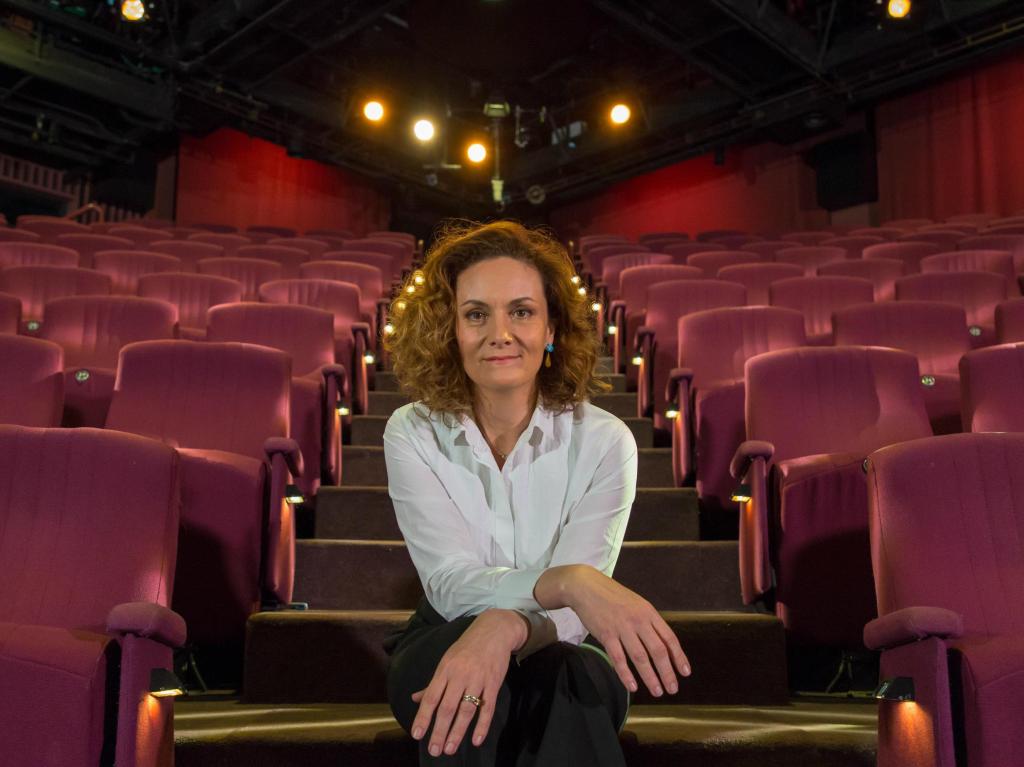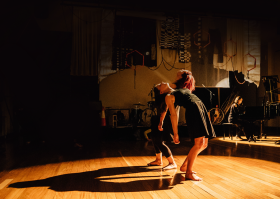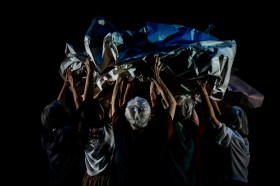Arts Centre Melbourne’s Claire Spencer is one of many speakers at the 2019 Creative State Summit. Photo credit: Mark Gambino.
As Victoria’s four-year Creative State strategy enters it final year and plans for the next four years get underway, it’s an appropriate time to consider what the future may hold for the cultural sector in Victoria and beyond.
That said, prognostication is hard work. Even five years ago, few would have predicted that the internet would become a place where harmful ideologies could take hold and where false facts could be actively disseminated.
‘There’s recently been a huge realisation that the technology of the last 25 years maybe hasn’t been so great for us,’ said Sebastian Chan, Chief Experience Officer at the Australian Centre for the Moving Image.
‘I think the optimism that we may have had until recently, maybe three or four years ago, has quickly evaporated, as people have seen that a networked world and the ability for anyone to make, publish and broadcast whatever they like hasn’t necessarily brought the kind of world we might have imagined into being.’
But a belief that we can change the world underpins Chan’s thinking when it comes to future-proofing the creative industries.
‘In many ways, making us think about alternative realties is what artists are good at,’ he said.
Chan, who led the digital renewal at New York’s Smithsonian Design Museum prior to joining ACMI, is one of many speakers from Australia and around the world who will be presenting at the third annual Creative State Summit, presented by Creative Victoria.
Running from 30-31 May at Melbourne Museum, the Summit – with the theme ‘What’s Next?” – will explore the innovations, opportunities, and disruptions that lie ahead for the creative industries – locally and globally.
Other guests at the summit, which is produced by REMIX, include Maxine Doyle, Associate Director at UK company Punchdrunk co-creator of the acclaimed New York and Shanghai productions of Sleep No More; Google Asia Pacific’s Creative Director Tara McKenty; and Nancy Bennett, Creative Director of Two Bit Circus, who currently leads the US company’s Virtual Reality arm, specialising in immersive 3D experiences.
‘In many ways, making us think about alternative realties is what artists are good at.’
We had the chance to chat to a collection of creative leaders who will be appearing at the Summit to give their take on the ideas, provocations and musings they’ll be sharing on and off stage at this year’s Summit.
Takashi Kudo is Communications Director at Tokyo-based collective, teamLab. Like Chan, Kudo has a keen interest in the role new technologies play in our lives, though his summit keynote will be exploring the topic from a very different perspective.
‘teamLab is an interdisciplinary group of ultra-technologists whose collaborative practice seeks to navigate the confluence of art, science, technology, design and the natural world,’ Kudo explained.
teamLab was founded in 2001 when a university student majoring in physics, joined forces with four friends who were studying engineering, robotics, philosophy and literature. The team has since grown to 500 people in Tokyo with smaller offices in Singapore, New York and Los Angeles. The collective has a jam-packed schedule of international exhibitions and projects each year and in 2018 it opened the world’s first digital art museum in Tokyo.
‘[We] aim to explore a new relationship between humans and nature, and between oneself and the world through art. Digital technology has allowed art to liberate itself from the physical and transcend boundaries. teamLab sees no boundary between humans and nature, and between oneself and the world; one is in the other and the other in one. Everything exists in a long, fragile yet miraculous, borderless continuity of life,’ he said.
ACCESS, LITERACY AND WELLBEING
Claire Spencer, CEO of Arts Centre Melbourne, will speak on a topic that is close to her heart: the mental health and wellbeing of artists and arts workers.
‘We’ve known anecdotally for some time that the mental health of entertainment and cultural industry workers is in distress, and this was backed up by research in a 2016 Victoria University report that showed high levels of mental health issues within our artistic industry,’ Spencer said.
Recognising this, in 2017 Arts Centre Melbourne joined forces with mental health professionals, other arts and cultural organisations and peak bodies to develop a tailor-made program to support the mental health and wellbeing of the creative community.
‘The Arts Wellbeing Collective is now in its third year and I want to share with the summit-goers how we can do this better together.’
Addressing the summit’s theme, Spencer believes that the wellbeing of the sector is vital to ensuring a stronger shared future.
‘Caring for our community and our people so we can be the best, and doing so, can offer the best experiences through our respective creative industry to local, national and international visitors. What’s Next is what is needed now to future-proof our industries by supporting our people,’ she told ArtsHub.
‘What’s Next is what is needed now to future-proof our industries by supporting our people.’
Arts Centre Melbourne is not alone in fighting for the wellbeing of the sector, with Seb Chan arguing that all cultural institutions, ACMI included, have an important role to play in building a stronger shared future.
‘[Institutions] also have a role in interpreting and making sense of artists’ work, and the processes through which those artworks are made,’ he said.
‘I’m talking about my museum particularly here. Being the national museum of film, TV, video games and digital art, showing how things are actually made is very important for building literacy; a literacy which then allows our communities to engage with a world of increasingly complexity and a world with problems that require us collectively to find solutions and different ways of working together – ways that we haven’t figured out yet,’ Chan said.
Referencing questions around data ownership and surveillance capitalism, Chan said: ‘These are difficult things to become literate about. They’re very difficult, complex systems that require artistic responses to help us all figure out how we feel about them and what we might collectively do about them.’
Learn more about the Creative State Summit.
A STATE SHAPED BY CREATIVITY
When considering the future of Victoria’s creative industries, it’s important to consider success stories from other sectors and states, according to Robbie Brammall, Director of Marketing & Communications at Hobart’s Museum of Old & New Art (Mona) and another keynote speaker at the Creative State Summit.
‘I always find it interesting to learn from and be inspired by people who have had success from creativity in other industries and fields,’ he said.
‘Creativity is pretty much driving every innovation in Tasmania at the moment – and to a degree that started in the cultural sector and the arts sector and now it permeates every sector.
‘If you’re doing something in Tasmania at the moment there is the expectation that you’re doing something inventive and risk-taking and creative – something that you can’t get away with on the mainland,’ Brammall explained.
‘Creativity is pretty much driving every innovation in Tasmania at the moment.’
Compared to the Tasmania Brammall knew when he was growing up, the island state is now thriving, with innovative thinking driving everything from the food and beverage sector to tourism.
‘If you look at the Tasmanian economy you’ve got Mona with its festivals like Dark Mofo and Mona Foma; you’ve got food and beverage production that has really taken off in the last five years – foraged botanicals and triple-distilled this and sheep’s milk that,’ he said.
‘You’ve got people taking abandoned hydro towns and turning them into accommodation; you’ve got people taking old asylums and making them chef-hatted restaurants … there are all these really interesting things happening all over Tasmania. There’s a lot more confidence and positivity as a result of that, and it all comes from the business advantage that you get from creativity.
‘And I think that’s the most positive thing that creativity can do – it can have an economic benefit that has all these other benefits for the rest of the community. I’ve certainly noticed that coming back to Tasmania and seeing it develop even in the two and a half years that I’ve been back – it is a very positive place now that has a bit of swagger. That certainly wasn’t the case 20 years ago,’ Brammall laughed.
TOWARDS A FUTURE AESTHETIC
Just as our ideas around the creative industries are constantly evolving, so too are our concepts of aesthetics and beauty, said Kudo, who together with his colleagues at teamLab is playing a long game.
‘Our intention is to change people’s standard of beauty, even if it requires a great deal of time,’ he said.
‘At some point in history, humans saw flowers and thought “beautiful.” But we do not really understand this phenomenon of “beauty.” Evolution explains some instances: it is natural that we would perceive other humans to be “beautiful” from a reproductive standpoint. But this does not explain why humans have found flowers “beautiful.”’
In theory, humanity should have developed different words to define what is aesthetically pleasing to us versus what is biologically attractive, Kudo explained, so the fact that we conceive of them in the same way ‘is quite miraculous’.
He continued: ‘We believe that art is an act of modern people creating their own flowers and expanding the notion of “beautiful”, in the same way that ancient human beings saw flowers as “beautiful” and expanded the idea of beauty. We do not instantly understand the reasons or meaning behind this expansion. However, through these positive expansions of “beautiful,” 30 or 50 years later, people may behave differently in a way that we cannot understand with today’s limited knowledge, allowing humanity to continue to grow and thrive.’
GATHERING THE TRIBES
Bringing people together from different states and sectors – from arts and culture to games development, filmmaking, fashion, design and more – to discuss contemporary issues and imagine alternative solutions is an essential part of the appeal of Creative State Summit.
Spencer said: ‘I’m a big supporter of an approach that puts collaboration at its centre and recognises that every part of our creative industries has something to offer and to learn from each other.
‘We are all much better when we work together and when we support each other. Collaboration is absolutely central to our day to day work and having a summit that is inclusive of all of our sector not only reflects the way we all need to work but provides a great opportunity to network that can spark new ideas and new ways of working.’
Seb Chan agreed, noting: ‘Bringing the different tribes together, different communities together, allows us to see new opportunities. People have found solutions in other adjacent fields to many of the issues that we face, and we need to talk about those solutions and how those solutions might be adapted for our sector.
‘We talk a lot in ACMI about convergence, and how convergence of media has completely changed our world, but also how the artforms that we are involved with are made, distributed, consumed and thought about.
‘Convergence is happening across all different artforms and sectors and a more diverse workforce can allow for far more creative thinking, bringing people from diverse sectors together allows more creative problem-solving – and also divergent thinking … That’s where the most interesting creative frictions occur,’ he concluded.
Creative State Summit 2019 runs from 30-31 May at Melbourne Museum. Visit creativestatesummit.com for program and ticket details.





